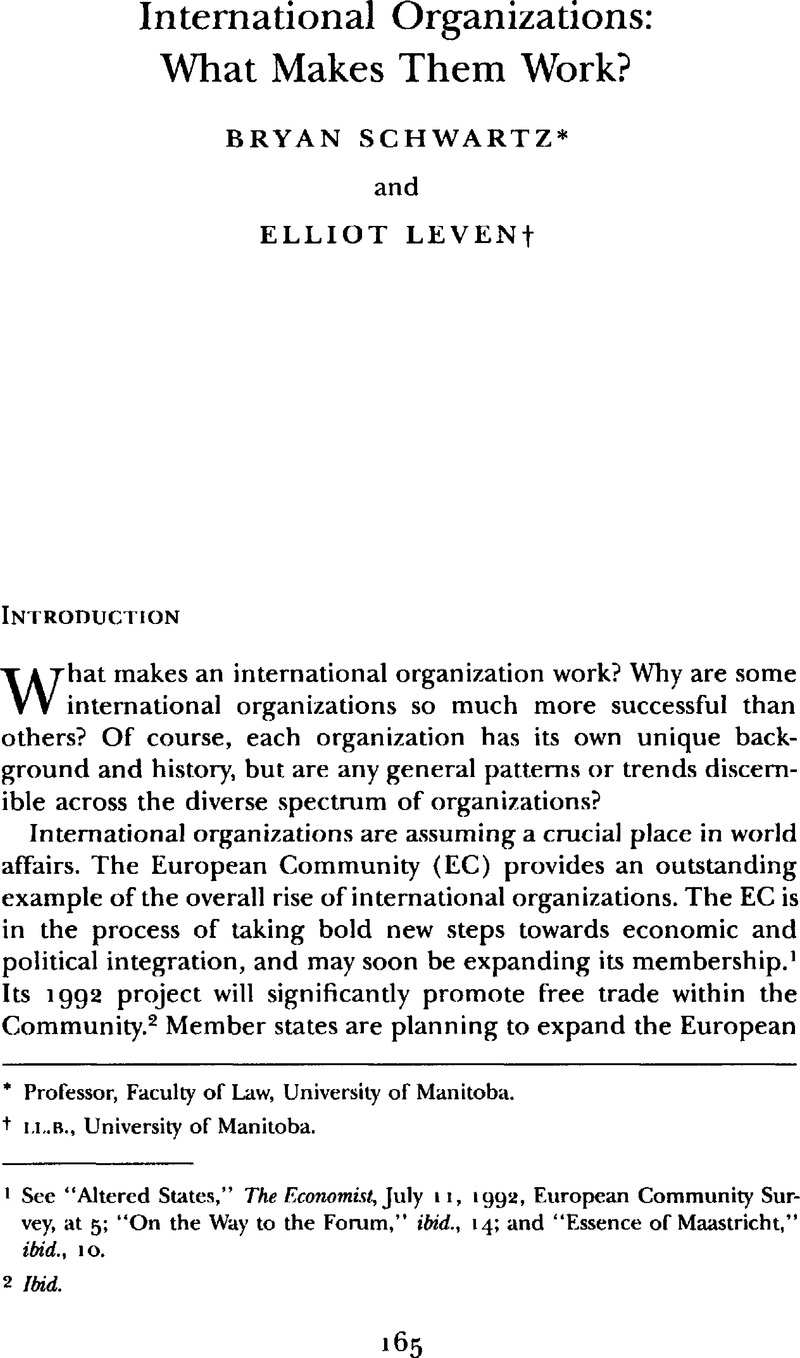Published online by Cambridge University Press: 09 March 2016

1 See “Altered States,” The Economist, July 11, 1992, European Community Survey, at 5; “On the Way to the Forum,” ibid., 14; and “Essence of Maastricht,” ibid., 10.
2 Ibid.
3 See “Memo to Maastricht,” The Economist, Nov. 30, 1991, at 69.
4 It is anticipated that Austria, Norway, and Sweden will become members of the European Community by 1996. Malta is slated to join by 2000. See “Altered States,” The Economist, July 11, 1992, European Community Survey, at 5.
5 See “The Tortoise and the Hare,” Time (Canadian edition), Sept. 10, 1990, at 20.
6 See “Altered States,” The Economist, July 11, 1992, European Community Survey, at 5.
7 See “On Russia’s Rim,” The Economist, Jan. 20, 1990, at 13.
8 See the interview with Quebec premier Robert Bourassa in Time (Canadian edition), July 9, 1990, at 10.
9 See “The World Bank and the IMF: A Panel,” 80 Am. Soc. Int’l L. Proc. 21–42 (1986).
10 See “Where the Buck Stops,” The Economist, May 6, 1989, at 48–50.
11 See “The Locomotive of 1992,” The Economist, Mar. 25, 1989, at 56–58.
12 See Luard, Evan, International Agencies: The Emerging Framework of Interdependence, 23 (London: Royal Institute of International Affairs, 1977).CrossRefGoogle Scholar
13 See “The International Law Commission,” 17 Victoria Univ. Wellington L. Rev. 1–6 (1987).
14 Lopina, David discusses the progress of ICSID through the 1980s in “The International Centre for Settlement Investment Disputes: Investment Arbitration for the 1990s,’” 4 Ohio State J. on Dispute Resolution 107–22 (1988).Google Scholar
15 See “Appraisals of the ICJ’s Decision: Nicaragua v. United Slates,” (Jan. 1987) 81 Am. J. Int’l L. 77–183 (1987).
16 See Stein, Ted L., “Contempt, Crisis and the Court: The World Court and the Hostage Rescue Attempt,” 76 Am. J. Int’l L. 499–531 (1982).CrossRefGoogle Scholar
17 See Europe Without Frontiers: Completing the International Market (Luxemberg: Office for Official Publications of the Communities, 1989).
18 The Economist captures some of the drama of this project in a survey titled “Europe’s Internal Market,” July 9, 1988.
19 See Eugene Sochor, “From the DC-3 to Hypersonic Flight: ICAO in a Changing Environment,” 55 J. Air L. and Com. 407–40 (1989).
20 Kapteyn, P.J.G. et al., International Organization and Integration, IB, 1.7.a. (The Hague: Mortimer Nijhoff Publishers, 1982).Google Scholar
21 See Luard, supra note 12, at 153–66.
22 Ibid., 240–63.
23 Ibid., 219–39.
24 The factor identified here has been the subject of a considerable literature revolving around the term “functionalism.” For a brief introduction, see Taylor, Paul, “Functionalism: the Theory of David Mitrany,” in Taylor, Paul and Groom, A.J. (eds.), International Organizations 236 (London: Francis Pinter Ltd., 1978),Google Scholar and R.J. Harrison “Neofunctionalism,” ibid.
25 Grenville, J. and Wasserstein, B., The Major International Treaties Since 1945: A History and Guide with Texts 64 (New York: Methuen, 1987).Google Scholar
26 Ibid., 92.
27 Ibid., 338.
28 Bums, Weston, et al., Basic Documents in International law and World Order 43 (St. Paul, Minn.: West Publishing, 1980).Google Scholar
29 The saga of Israel and UNESCO is chronicled by Kirgis, Frederic Jr., in International Organizations in their Legal Setting: Documents, Comments and Questions 547–53 (St. Paul, Minn.: West Publishing, 1977).Google Scholar
30 In 1990 the total debt/arrears of the United States to the UN and its agencies was approximately $438 million.
31 See Williams, Douglas, Specialized Agendes and the U.N.: The System in Crisis 160 (New York: St. Martin’s Press, 1987).Google Scholar
32 See Scheman, L. Ronald, “The OAS and the Quest for International Cooperation: American Vision or Mirage,” 13 Case Western Reserve!. Int’l L. 83–105 (1981).Google Scholar
33 See “Renaissance on the East River,” The Economist, Dec. 15, 1990, at 43–44.
34 See Feld, W. and Jordan, R., International Organizations: A Comparative Approach 173–78 (New York: Praeger, 1983).Google Scholar
35 See “GATT Brief,” The Economist, Apr. 21, 1990, at 85–86.
36 One economic weapon that seems to be quite practical and effective is freezing the assets of an adversary. For example, it seemed to produce results (eventually) in the U.S.-Iran hostage situation.
37 While conditions imposed on IMF loans have produced popular resentment, even the occasional riot, it is doubtful that the resentment is comparable to that which would result from measures such as embargoes or military action that are more clearly punitive.
38 “The powers that be,” The Economist, Feb. 25, 1989, at 49–50.
39 See Moy, Linda L., “The U.S. Legal Role in International Labor Organization Conventions and Recommendations,” 22 Int’l Lawyer 767–74 (1988).Google Scholar
40 Treaty of European Union, Protocol on Certain Provision Relating to the United Kingdom of Great Britain and Northern Ireland, 31 Int’l Leg. Mat. 247, 355 (1992).
41 See “Dreaming Spires,” The Economist, European Community Survey, July 11, 1992, at 29.
42 Scott, George argues that, during most of its history, the League actually functioned better than many people realize, in The Rise and Fall of the league of Nations (London: Hutchinson and Co., 1973).Google Scholar
43 See “General Jacques De Gaulle,” The Economist, June 16, 1990, at 58.
44 The Economist, Apr. 28, 1990, al 80–81.
45 Kapteyn, supra note 20, at II.G.i.a.